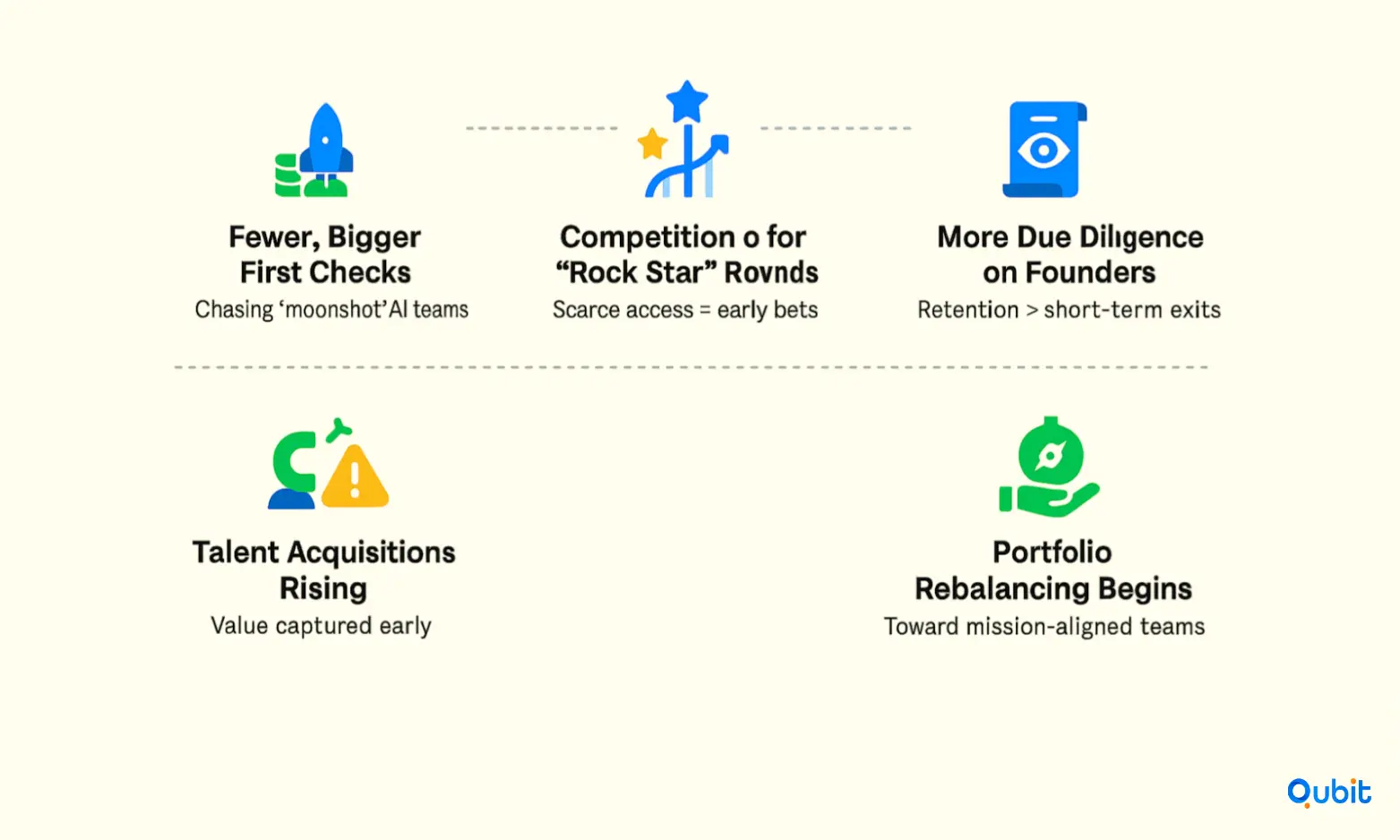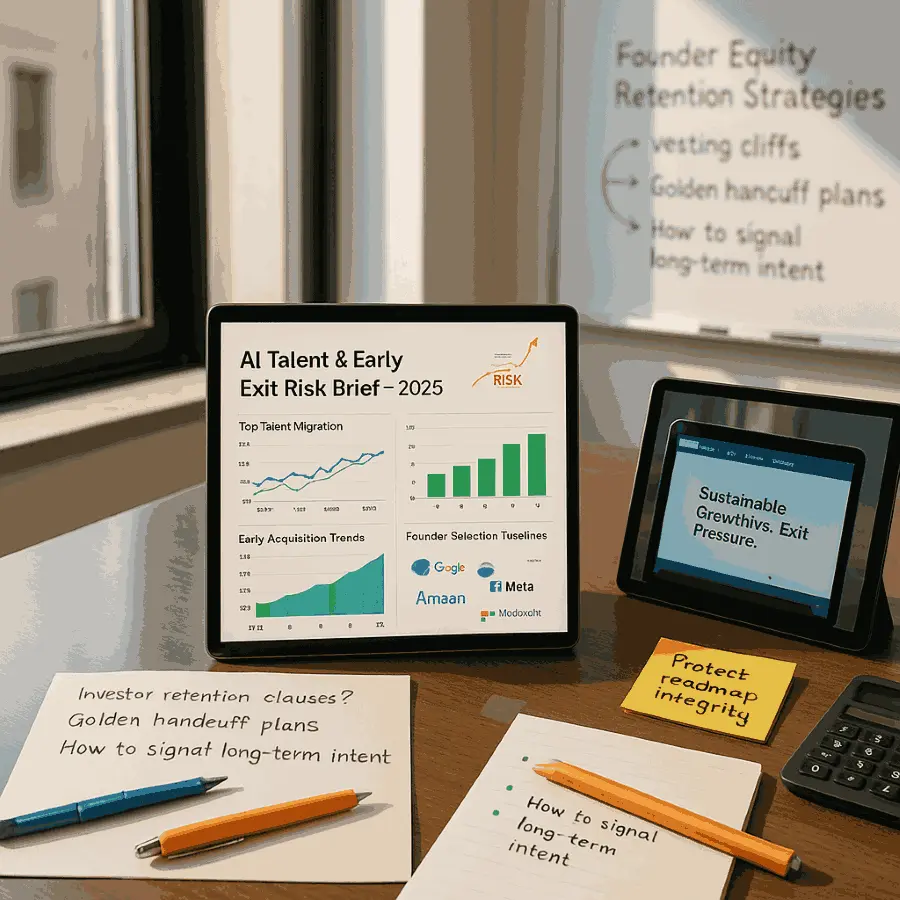The AI revolution is redrawing the battle lines for talent and reshaping what success, and risk, means for investors. The "AI talent wars" are at fever pitch in 2025, not only driving sky-high compensation packages but also fueling a volatile cycle of early funding, high-velocity exits, and profound questions about sustained value creation. For founders, funds, and corporate strategists alike, understanding how these dynamics alter long-term investor value is no longer optional, it’s essential for making sound, future-proof investment decisions.
A broad analysis of funding tactics gives you clarity on how to raise money for AI startup by establishing a strategic framework that underpins later follow-up communications. This connection between pitching and follow-up ensures that your efforts resonate with investors and keep your startup top of mind.
Let’s explore actionable strategies to turn post-pitch follow-ups into winning opportunities.
AI Investment, Funding and Exit Dynamics: Addressing the Funding-Exit Disparity
The AI startup ecosystem is experiencing a paradoxical surge. While U.S. venture funding for AI startups reached an unprecedented $104.3 billion in the first half of 2025, exit returns lag significantly behind at just $36 billion. This stark contrast has left investors grappling with valuation pressures and questioning the sustainability of current funding trends. The disparity is further underscored by the dominance of lower-value acquisitions, with 281 exits recorded during the same period.
The Funding Boom: Generative AI’s Role in Shaping Investor Behavior
Generative AI has emerged as a transformative force, reshaping venture capital priorities. Following its breakout year in 2024, VC allocation toward AI nearly doubled, from 22% to 42%, as investors scrambled to capitalize on its potential. High-profile raises such as OpenAI’s $40 billion and Scale AI’s $14.3 billion exemplify the magnitude of capital inflows. However, these raises also highlight the challenges of translating massive valuations into sustainable exit returns.
Two-thirds of U.S. venture funding now flows to AI startups, creating a hyper-competitive environment for dealmaking. While this dominance reflects confidence in AI’s transformative capabilities, it also exacerbates funding–exit imbalances. As reported by CNBC via Pitchbook, the record-breaking $104.3 billion raised in H1 2025 starkly contrasts with the modest $36 billion in VC-backed exits. For a detailed overview of this disparity, refer to the CNBC report on $104.3B funding vs. $36B exits.
Exit Challenges: Acquisition-Driven Outcomes
The exit landscape for AI startups remains constrained, with acquisitions dominating the scene. Of the 281 exits recorded in H1 2025, most were lower-value deals, reflecting limited opportunities for IPOs or high-value mergers. This trend has left many investors questioning the sustainability of current valuations, particularly as generative AI startups continue to attract outsized funding.
Reports from PYMNTS highlight the funding–exit imbalance, emphasizing the need for startups to recalibrate their strategies to align with realistic market expectations.
What AI Talent Wars Mean for Investor Value
1. Increased Burn and “Winner-Take-Most” Economics
Salaries and equity packages for the best AI minds have sharply increased burn rates at early-stage firms. Startups are pressured to close bigger rounds, fastest, sometimes at the cost of long-term equity discipline or capital efficiency, just to stay in the game. Sustaining a world-class tech team can quickly outpace revenue, with infrastructure and compute costs compounding the risk.
For investors, this means the window to prove out product-market fit and move up in valuation is narrowing, and capital is deployed with higher upfront risk. When combined with a scarcity of technical depth at scale, this dynamic exacerbates “winner-take-most” patterns, where a small number of companies attract outsize returns, and many others struggle or are acqui-hired on suboptimal terms.
2. The Rise of Early (and Sometimes Disappointing) Exits
Driven by fierce poaching and relentless M&A interest, especially from the largest tech firms hungry for both models and talent, AI startups are exiting earlier than in previous tech cycles. In 2025 alone, VC-backed exits in the U.S. hit 281, with total cash-outs ($36 billion) lagging behind the $104 billion in capital invested in the same period. Early exits increasingly take the form of lower-value acquisitions or “acquihires”, where the real asset is the team itself, not necessarily a differentiated product or sustainable business model.
While early exits can lock in short-term returns for first-money investors, they frequently truncate longer-term value generation, leading to subdued multiples and, for some late-stage funds, disappointing cash-on-cash outcomes compared to headline valuations. This is especially acute when exits are driven by defensive acquisitions: Not a market win, but an admission that scaling independently was too capital-intensive for the startup to continue.
3. Impact on Investor Strategy and Fund Dynamics
These pressures are already reshaping fund strategies:
- Shorter Holding Periods: VCs are accelerating their timelines—pushing companies for faster growth, earlier proof points, and “optionality” (including M&A) rather than defaulting to the long hold-and-scale playbook.
- Preference for Elite Talent: Investors increasingly prioritize teams with “gold star” AI pedigrees, sometimes over fundamentals of business model durability or TAM. This compounds both opportunity and risk.
- Bigger, Fewer Bets: To win access to top founders or teams, funds end up writing larger checks for fewer companies. betting that the outsized returns from a few hits will outweigh frequent early (often modest) exits or losses.
- Follow-On Risk: With so many companies burning capital at record rates and chasing the same talent, follow-on funding becomes riskier, leading VCs to focus support on breakouts and leave others to exit early or wind down.
A methodical game plan turns follow-up efforts into measurable success, bridging initial targeting with effective investor communications. For a deeper dive into early-stage outreach strategies, explore our guide on how to find investors for AI startup. This resource explains how systematic planning leads from targeting investors to effectively following up.
Long-Term Value Creation: Persistent Headwinds
A. “Mercenary Mindset” and Retention
The culture of job-hopping and “mercenary” career moves—emboldened by huge pay packages and fast-moving opportunities—poses unique retention challenges1. Startups may lose key staff mid-flight, jeopardizing both core IP and continuity of execution. For investors with significant equity locked up beyond first founders, this creates additional risk that value will “walk out the door” in the next talent cycle.
B. Uneven Distribution of Acquihire Value
High-profile acquihires and team-focused M&A deals may disproportionately benefit early technical hires, often leaving other shareholders (and sometimes investors) with less-than-expected outcomes compared to a true commercial exit. This diverges from the classic VC model of scaling a product company to independent profitability and a robust public market valuation.
C. Early Exits vs. Ecosystem Maturity
A market where every startup aims to be a billion-dollar acquisition, rather than a sustainable company, can undermine ecosystem maturity and long-term value. For broader investor value, the proliferation of “startup-for-acquisition” mindsets dilutes returns and incentivizes short-term thinking over building defensible, durable businesses.
Strategic Responses for Investors and Founders
- Focusing on Founder Retention: Funds now co-invest in creative incentives, vesting schedules, and cultural alignment to minimize flight risk.
- Backing Mission-Driven Teams with Moats: The most defensible AI startups build advantages around proprietary data, customer networks, regulatory compliance, and differentiated product-market fit, not just talent clustering.
- Assessing Exit Scenarios Early: Investors evaluate likely buyer profiles, acquihire valuations, and the probability of a genuine commercial exit before investing, often structuring terms to protect against shallow early exits.
- Supporting Talent-Driven Culture: The best AI startups invest in long-term employee engagement, hybrid talent strategies, and cultural practices to foster technical loyalty and attract a broader pool beyond “superstars.”
What the Future Holds
The AI talent wars and early exit surge have compressed the investment cycle, pitting founders and funds against a high-stakes, high-reward, but also high-risk, market environment. While the value of technical brilliance is undeniable, overreliance on talent as the sole moat creates vulnerabilities for both company and investor value over the long term.
Ultimately, sustainable value in AI will accrue to those that blend world-class talent with business model rigor, product-market fit, defensible IP, and the ability to navigate (rather than just exploit) the boom-and-bust cycles of a fast-evolving industry. For investors, disciplined underwriting, focus on mission-aligned teams, and a clear-eyed view of exit dynamics are critical for converting the headline excitement of the AI era into lasting portfolio returns.
2025’s High-Stakes AI Talent Moves and Acquisitions
The headlines of 2025 are filled with blockbuster deals and talent moves that underscore just how intense the AI arms race has become. Recent examples tell the story best. In the year’s most talked-about acquihire, Meta spent $14.3 billion not just to acquire Scale AI’s technology, but to secure its CEO and principal research team, outbidding traditional rivals and making clear that elite talent now commands a premium far above IP or revenue alone. In another case, Google’s $2.4 billion acquisition of Windsurf Labs was motivated primarily by a desire to lock down their breakthrough LLM scientists before they could be poached by next-generation upstarts or competing Big Tech giants.
Further amplifying the competition, OpenAI and Meta reportedly offered retention bonuses well above $100 million for “franchise player” engineers, making their hiring and compensation processes faster and more personally tailored than any time in the past. In these deals, founders and investors alike have seen how the speed and focus of a talent-driven acquisition can dramatically reshape the value equation, sometimes creating impressive short-term wins, but leaving question marks about downstream value capture for shareholders and ecosystem players.
These moves also thin the talent pool for emerging startups, raise salary expectations industry-wide, and pressure edgy, research-driven teams to consider early exits simply to grant their staff quicker liquidity, rather than pursue long-run independence.
Direct Investor Perspective on Early Exits and Value
The shifting landscape is also altering how investors build and protect value in their portfolios. The risk of losing technical teams to high-velocity, talent-driven acquisitions is forcing many venture capitalists to rebalance their own strategies.

Increasingly, funds are writing larger first checks for a smaller number of “moonshot” teams while competing harder to win allocation in rounds led by AI “rock stars.” Late-stage investors, once drawn to the prospect of outsized returns from a mature, independent AI exit, must now grapple with the reality that many exits take place at earlier stages and lower multiples, especially if driven by talent, not commercially scaling platforms.
Some investors are also reexamining their portfolio construction to emphasize “mission-oriented” teams and cultures where technical founders align their equity and growth ambitions with the long game, rather than viewing the company as a stepping stone to a top-tier job offer. This means greater focus during due diligence on founder retention strategies, equity vesting beyond the initial round, and contractual protections around talent continuity through earn-outs or strategic milestones post-acquisition.
Operational and Strategic Adjustments for Founders
Founders in the 2025 are no longer assuming that great science alone will keep their teams together or their companies independent. Instead, the most successful leaders are adjusting on several fronts:
- Front-Loading Equity and Accelerating Vesting: To attract and lock in elite talent, founders are increasingly willing to offer larger initial equity grants and front-loaded vesting schedules, often with “founder-style” equity for transformative hires.
- Building a Culture of Impact and Belonging: Creating an environment where cutting-edge work, ownership, and personal/professional development matter as much as compensation. This sense of mission is crucial to keeping teams together and loyal amidst competitive poaching.
- Selecting the Right Investors: Today’s AI founders strategically target investors with patience, understanding of the unique economics of deep learning startups, and the willingness to support long-term programs even when tempting exit offers arise.
- IP and Data Moats: Companies are doubling down on proprietary datasets, customer relationships, and differentiated deployment strategies to ensure that company value does not simply walk out the door if a handful of top engineers leave.
Conclusion
A well-crafted pitch is only as effective as the follow-up strategy that supports it. Throughout this blog, we’ve explored the significance of personalized and timely follow-ups, emphasizing how they can transform initial interest into meaningful engagement. By adopting a data-driven approach, startups can refine their communication strategies to resonate with their audience and maximize impact.
Equally important is the role of storytelling in creating a compelling narrative. A structured, narrative-driven pitch combined with an organized follow-up process ensures that your message not only reaches your audience but also leaves a lasting impression.
If you’re ready to elevate your pitch and refine your communication strategy, we’re here to help. Review and refine your pitch communications with our expert Pitch Deck Creation service – get in touch with us today.
Key Takeaways
- AI funding is booming but exit returns remain disappointingly low, revealing a major funding-exit imbalance
- Elite talent is the new currency driving up burn rates and making startups exit earlier often before reaching full potential
- Acquihires dominate AI exits where teams are bought not products leaving long-term value on shaky ground
- Investors are shifting strategies backing fewer companies with bigger checks and obsessing over talent retention
- Founders must outthink poaching by offering front-loaded equity IP moats and a culture that breeds loyalty
- The game isn't just about raising it’s about follow-through with strategic follow-ups and storytelling being just as crucial as the pitch
Frequently asked Questions
What is the best way to follow up after an AI pitch?
The most effective method involves sending a personalized follow-up email within 5–7 business days. Reference your initial pitch and include new, relevant information to reignite interest. This approach ensures your message stands out and fosters engagement.






